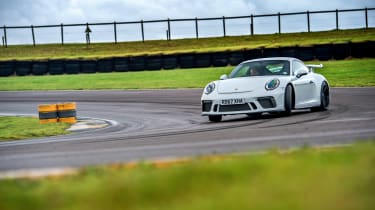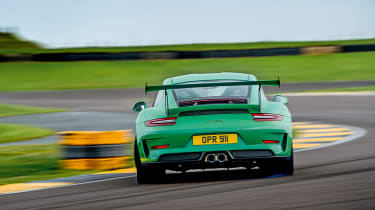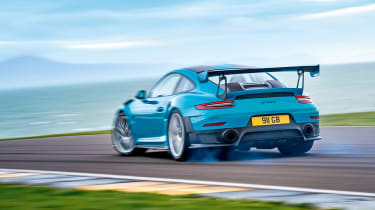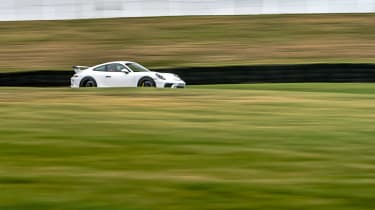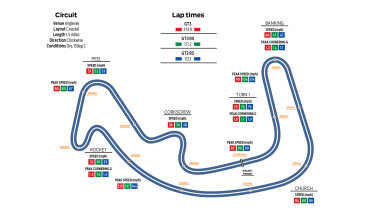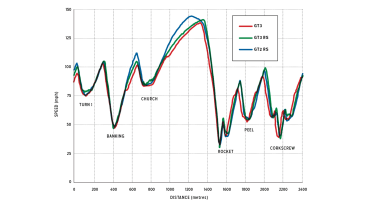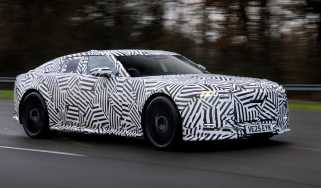Porsche 911 GT3 vs GT3 RS vs GT2 RS - track battle
Porsche’s GT3, GT3 RS and GT2 RS are the most hardcore of the 911 breed, but pitched head‑to‑head which will we crown champion?
Porsche has always done extreme 911s, but it’s rare for it to have three variants on sale simultaneously. So in the interest of science – and because what better way to celebrate a 70th anniversary – we’ve gathered together the current GT3, GT3 RS and GT2 RS at Anglesey Circuit to discover which is the king of 911s.
GT3 first, and thanks to Porsche’s volte-face on its PDK-only policy for GT models, this a rare opportunity to try a state-of-the-art car with a traditional manual transmission. It doesn’t disappoint. Porsche has continuously improved its seven-speed manual, but this six-speed version is even better. There’s a switchable auto-blip function, which gets some people very hot under the collar, but I actually rather like it, even if I do prefer to do the blipping myself.
> New 2018 Porsche 911 GT3 RS review – the best just got even better
This Gen 2 991 GT3 really is a great example of how Porsche squeezes the juice from a car so hard you can almost hear its pips squeak. Going from 3.8 to 4 litres brings torque benefits, but considerable effort was also made to reduce frictional losses. The result is 493bhp, 339lb ft and a rev limiter at 9000rpm, plus a spine-tingling soundtrack that’s taken straight from the racetrack. Finished in a stormtrooper scheme of white with black detailing this GT3 looks surprisingly restrained, thanks largely to the modest rear wing and lack of additional slots and scoops that pepper the RSs. It’s still a brilliantly focused machine, though: simple, functional and supremely fit for purpose.
More reviews
In-depth reviews
- Porsche 911 Carrera GTS T-Hybrid review – the first hybrid 911 is one of the best
- Used Porsche 911 (991, 2011 - 2018) review – should you buy the unloved 911?
Long term tests
Reviews
- New Porsche 911 Turbo S review – McLaren Artura performance with four seats
- RML GT Hypercar review – the Porsche 911 taken to the ultimate extreme
- Used Porsche 911 (997, 2004 - 2012) – the ultimate sweet spot 911
- Porsche 911 Turbo S (992.1, 2020 - 2024) review – Stuttgart’s supercar slayer
- Porsche 911 3.2 Carrera (1984 - 1989) review – flawed but furiously charming
At first it feels strange to be pumping a clutch pedal and working a gearlever, but Porsche clearly hasn’t forgotten about the importance of matched control weights and smooth, well-judged response. Anglesey don’t worry too much about noise, so it seems rude not to open the exhaust, and as the surface is smooth it’s also right to crank the PASM into its stiffest mode.
The GT3 is a fabulously communicative car to drive hard. There’s a level of pliancy and progression to help you feel your way towards its limits, but also great depths of grip and traction from which to draw. Having to change gear the old-fashioned way adds to the workload, but it unquestionably bonds you more closely to the process of going quickly, not to mention gives you tremendous cause for satisfaction when you nail your upshifts and downshifts for a whole lap.
After a couple of five-lap runs the Vbox settles on a best of 1:13.9. That’s 0.5sec shy of the time I set in a PDK GT3 last year (evo 236), which I don’t think is too shabby. The PDK car definitely has its own appeal, but the pleasure of working the manual transmission more than offsets the fractional sacrifice in pace.
GT3 RS next, and there’s no point denying it: I have the major hots for this car. Have done ever since I drove it on the launch. I suspect this love is not universally shared, at least not by those who have got used to the previous-generation 3RS being a genuinely everyday useable car. Personally I’ve always thought an RS should be hardcore. Or at least have enough attitude to make it too much for some to tolerate. That the Gen 2 991 version goes this far is something to celebrate, for it shows Porsche is always willing to push the boundaries. It really does have the heart and soul of a racer, and the looks to match – made even more attention grabbing by this example’s Lizard Green paintjob. It all helps create a greater level of expectation and anticipation for the driving experience to come.
> New 2017 Porsche 911 GT3 review - is it still the best of the breed?
There’s certainly more grit to its delivery than the GT3 and a sense that you’re one layer closer to the working parts of the car – a result of less sound-deadening to save a few more kilos. It’s the first clue to the 3RS’s pricklier character, which reveals itself more completely once we’ve cleared the pitlane and powered out onto the circuit.
Fabulous though it is in the GT3, the naturally aspirated 4.0 flat-six has a more serrated edge and even more snap when you squeeze the throttle in the RS – delicious, visceral confirmation of the spec sheet gains of 20bhp and 8lb ft, taking the totals to 513bhp and 347lb ft. Outright pace – if not driver interaction – is further enhanced by the mandatory fitment of the super-quick-shifting PDK ’box.
The feeling of urgency and aggression is captivating from the moment you get some heat in the tyres – doubly so if, as here, they happen to be Michelin’s freakishly effective Pilot Sport Cup 2 Rs. These are the tyres used to set Porsche’s Nürburgring records, and whenever you ask the RS to stop, steer or accelerate you can see why. They are voodoo.
We also try some laps on regular Cup 2s, but the track is damp in places when these are fitted, preventing the car from truly finding its feet. What’s clear from both efforts, however, is the 3RS’s beautiful balance and incredible ability to support quick changes of direction – both areas of improvement credited to the RS’s rose-jointed suspension and significant gains in aerodynamic downforce.
Inevitably this means a little more of the 911’s rear-engined traits have been erased in the pursuit of poise and pace, but they’re still there to be exploited if you’re prepared to dig deep enough and want to slide it around. Not that you’ll wish to do so on Cup R’s, for the thrill is bound up in the unique level of adhesion they generate.
> 991.2 Porsche 911 GT2 RS review - monstrous performance drives 911 to a new level
It’s been a while since the difference between GT3 and 3RS has been this marked. Indeed I’d say you need to go right back to the Gen 2 996 to find such an uncompromising RS, but in creating greater separation between these closely related models Porsche has actually improved both.
We’ll take a look at the 3RS’s lap time shortly, but before that, on to the GT2 RS. From the moment you fire it up you know you’re in for a very different experience. Clearly working on the principle if you’re going to be a bear, be a grizzly, the GT2 throbs and pulses with anger and energy. Its engine note is deeper and more malevolent, even at idle. This is a piece of heavy artillery, no question.
There are close similarities in set-up between the 3RS and the 2RS, so it’s no surprise to feel that familiarity through the steering and the seat of your pants. It’s lighter in your hands than you might expect, but once you get heat into its Cup 2s it keys in and the feel begins to flow through your fingers.
What transforms the experience is the utterly different delivery of the monster twin-turbocharged motor. Where the naturally aspirated 4.0 is ultra-sharp and builds to a wild crescendo of revs, this turbo’d 3.8 has a ballsier, more muscular demeanour. It thumps hard and early, wrapping you in a straightjacket of longitudinal G-force and working the chassis and tyres in a less linear way. Of course, there’s still finesse to the way it goes to work – this is no laggy, old school F40 – but the sheer torque on tap means you need to be a little more sympathetic to the rear tyres’ workload and sometimes pre-empt when the meat of the boost will arrive.
The GT2 RS places a different emphasis on your driving, too. The difference in peak speeds along Anglesey’s modest straights isn’t massive, but you do have to focus a little harder on nailing your braking markers, as the extra few mph (and the extra few kilos) place even more emphasis on the braking zones. You really notice it heading through the ultra-fast uphill kink on the approach to Radar, as the speed is pretty eye-widening. Just like in the GT3 and GT3 RS you can take the kink flat, but you always end up struggling to get slowed for the tight left-hander. It’s the most critical braking zone in the entire lap, and thanks to the way it plateaus it’s also the easiest to make a hash of.
The tight left-right section that follows (and the Corkscrew later in the lap) is where the 2RS’s additional weight and softer engine response are most apparent. It’s far from lethargic, obviously, but there’s just that fraction more inertia to its direction changes and you can’t make the fine throttle adjustments that help to tickle the GT3s through with such deftness and precision. That said, it counters with monumental shove out of the corners and down the straights. It’s the kind that always makes your heart beat faster and harder and gives rise to a slightly giddy feeling as your innards are shifted within your body cavity.
What’s more, the 2RS deploys this epic power (690bhp) and torque (553lb ft) with astonishing effectiveness. Yes, you can light it up and bonfire the tyres – fun if you’re not paying for the replacement rubber and testament to how well the 991 handles outputs that would just a few years ago have seemed like lunacy in a 911 – but the measured exploitability of the 2RS’s performance is just as remarkable.
It’s in marked contrast to the 997 GT2 RS, which was a real flick-knife of a car. Whether or not the new car could do with a little more of its predecessor’s ferocity is up for debate. The current car is certainly more docile than you’d ever expect from a near-700bhp 911, but I’m not sure I’d want it to be quite as explosive as the 997!
It might not feel like it wants to kill you, but the 2RS is a big character. In fact it’s almost two cars in one: civilised enough to work as a road car in which you’d be happy to cover big miles, yet wild enough to deliver an intense adrenaline rush if you’re prepared to hang it out.
It’s fascinating to discover the differences between these three closely related 911s. Taken in isolation each is a magnificent car, but stepping from one to the other gives you a wonderfully warped perspective. How else can you explain feeling that the manual GT3 is the soft and friendly member of the trio?
Of course, it’s not soft by any normal benchmark, but relative to the significantly stiffer and solid-mounted RSs it feels much more rooted in road use. The manual transmission adds a layer of interaction, but turns down the intensity a notch. The 4-litre motor is magnificent, but it doesn’t quite have the final nth degree of response and aggression possessed by the RS GT3. And, of course, it doesn’t have the stonk of the GT2 RS.
And what of the comparison between the two RSs? Honestly, despite the shared chassis set-up they are different enough that you could easily justify having both in your garage. I love the 2RS’s potency and the ferocity of its on-boost acceleration. I also love the immense force with which it pulls a tall gear. It’s everything you want a hardcore turbocharged 911 to be.
However, for me it’s the GT3 RS that leaves the biggest impression. Not just because of its lap time on Cup R rubber – though, as you can see on the opposite page, it is extraordinary – but because it represents the zenith of the naturally aspirated 911. How the upcoming 992 GT3 RS can improve the breed is hard to imagine. But then it wouldn’t be the first time we’ve thought that…
| Porsche 911 GT2 RS | Porsche 911 GT3 | Porsche 911 GT3 RS | |
| Engine | Flat-six, 3800cc, twin-turbo | Flat-six, 3996cc | Flat-six, 3996cc |
| Power | 690bhp @ 7000rpm | 493bhp @ 8250rpm | 513bhp @ 8250rpm |
| Torque | 553lb ft @ 2500-4500rpm | 339lb ft @ 6000rpm | 347lb ft @ 6000rpm |
| Weight | 1470kg | 1413kg | 1430kg |
| Power-to-weight | 477bhp/ton | 355bhp/ton | 364bhp/ton |
| 0-62mph | 2.8sec | 3.9sec | 3.2sec |
| Top speed | 211mph | 198mph | 193mph |
| Basic price | £207,506 | £111,802 | £141,346 |
Lap analysis
To our immense frustration, fickle Welsh weather meant we were unable to set a meaningful lap time in the GT3 RS running on the non-R Cup 2 tyres. On an almost dry track on Cup 2s it posted a 1:14.1 – just a couple of tenths shy of the regular GT3 in perfect conditions on the same tyre. It’s dangerous to guess at what it might have done without the lingering damp patches to contend with, but given we’ve posted a 1:13.4 in a PDK GT3 I’m pretty certain the 3RS would dip into the high 1:12s.
However, we did get a dry run on the super-sticky Cup 2 Rs. The resulting lap time was a jaw-dropping 1:11.2 – not only 0.9sec faster than the ballistic GT2 RS’s best in the dry on regular Cup 2s, but identical to our time (from evo 200) for the McLaren P1 on Pirelli P Zero Trofeo Rs. Let that sink in for just a moment.
Aside from the mighty speed of the 3RS on extreme Michelin rubber, our lap traces show just how much speed the 2RS gains between the apex of one corner and braking zone of the next. For example, from Church to Rocket the 2RS turns a 2mph deficit to the 3RS into a 7mph advantage, punching from 86mph at the apex of the former to 144mph before the braking area into the latter. For context, the GT3 pulls from 84mph to 135mph in the same distance.
All three cars were fabulous to lap, but the 3RS on those crazy R tyres was truly extraordinary. Would the 2RS drop into the 1:10s on the same rubber? I’d love to find out.

